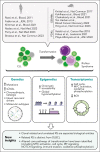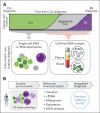Richter syndrome: novel insights into the biology of transformation
- PMID: 36758208
- PMCID: PMC10356575
- DOI: 10.1182/blood.2022016502
Richter syndrome: novel insights into the biology of transformation
Abstract
Although the genetic landscape of chronic lymphocytic leukemia (CLL) has been broadly profiled by large-scale sequencing studies performed over the past decade, the molecular basis of the transformation of CLL into aggressive lymphoma, or Richter syndrome (RS), has remained incompletely characterized. Recent advances in computational methods of clonal deconvolution, as well as extensive sample collection efforts in this rapidly progressive malignancy, have now enabled comprehensive analysis of paired CLL and RS samples and have led to multiple new studies investigating the genetic, transcriptomic, and epigenetic origins of RS. In parallel, new genetically engineered and xenograft mouse models have provided the opportunity for gleaning fresh biological and mechanistic insights into RS development and stepwise evolution from antecedent CLL. Altogether, these studies have defined RS driver lesions and CLL risk lesions and identified pathways dysregulated in transformation. Moreover, unique molecular subtypes of RS have been revealed, including a disease marked by profound genomic instability with chromothripsis/chromoplexy and whole genome duplication. Novel profiling approaches, including single-cell DNA and transcriptome sequencing of RS biopsy specimens and cell-free DNA profiling of patient plasma, demonstrate promise for the timely identification of RS clones and may translate to noninvasive identification and early diagnosis of RS. This review summarizes the recent scientific advances in RS and supports the integrated study of human genomics with mouse modeling to provide an advanced understanding of the biological underpinnings of transformation. These recent studies have major implications for much-needed novel therapeutic strategies for this still largely incurable malignancy.
© 2023 by The American Society of Hematology.
Conflict of interest statement
Conflict-of-interest disclosure: C.J.W. and E.M.P. are named as inventors on US provisional patent application serial number 63/244,625, filed on 15 September 2021 and US provisional patent application serial number 63/291,213, filed on 17 December 2021, both of which are entitled “Diagnosis and Prognosis of Richter’s Syndrome”; C.J.W. receives funding support from Pharmacyclics and holds equity in BioNTech, Inc. E.t.H. declares no competing financial interests.
Figures





References
-
- Black JRM, McGranahan N. Genetic and non-genetic clonal diversity in cancer evolution. Nat Rev Cancer. 2021;21(6):379–392. - PubMed
Publication types
MeSH terms
Grants and funding
LinkOut - more resources
Full Text Sources
Miscellaneous

